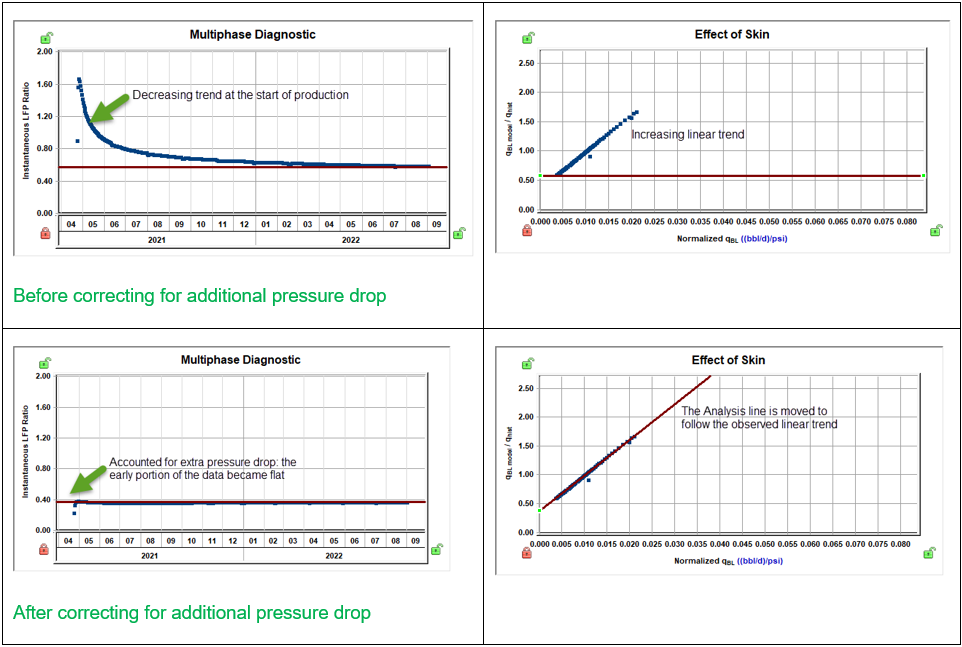The numerical unconventional reservoir model (URM) analysis was developed based on URTeC-2020-2967-MS and accounts for multiphase behavior, including total compressibility change when pressure drops below saturation pressure. Similar to the traditional URM analysis, numerical URM is used to determine the following: the linear flow parameter (LFP or Ac √k) and the size of SRV (ASRV or OFIPSRV.
Summary of methodology
Consider two similar models for a horizontal multi-fractured well. Both models have:
- SRV geometry (exhibit linear flow followed by boundary dominated flow)
- same initial pressure
- same PVT properties
- same relative permeability curves
- same porosity and initial saturations
- pressure control calculation (using same historical pressures)
However, these two models may have different LFP (Linear Flow Parameter = 4hxf nf √k).
This can be visualized as two models where just the number of fracture stages nf is different (but the same would apply if h, xf, or k are different).
In this case, rates produced by these two models are proportional to their LFP ratio:

Now we use this concept to analyze actual well data. We build any model to use as model 1 (as long as it has SRV geometry and stays in linear flow); this model will have the same PVT properties, relative permeabilities, initial pressure, and saturations as the well being analyzed. We call this model the Base Model. LFP for the Base Model is known. The Base Model is calculated with pressure control to obtain qBaseModel rates.
Instead of model 2, we use the actual historical production data of the well:
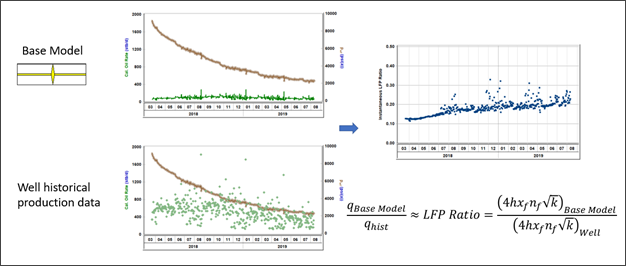
The LFP ratio can then be estimated from the  dataset (plotted against time), and then LFP of the well can be calculated as:
dataset (plotted against time), and then LFP of the well can be calculated as:

The LFP of the well is the main output from Numerical URM analysis.
Additional outputs, options, and calculations are described in detail in the subsequent sections.
Assumptions
The analysis are done on a production dataset (rates and flowing pressures) for a horizontal multifrac well. It is assumed that the dataset being analyzed can be modeled closely using a numerical model. This model is referred to as the history-matched model (HM model). It is assumed that the following is true about this model:
- Model geometry is supposed to be an SRV geometry; therefore a linear flow regime is expected for the well followed by boundary-dominated flow.
-

- Initial reservoir pressure, PVT properties, and relative permeabilities are assumed to be known (should be entered in the Properties editor).
- Geological parameters such as porosity, net pay, saturations, rock compressibility, and pressure-dependent permeability are assumed to be known (should be entered in the Properties editor.
- Other model parameters such as LFP (Ac √k), kSRV, telf, xf, and OFIPSRV are unknown and can be estimated using the numerical URM analysis.
Essentially, the numerical URM analysis assumes that well behavior can be closely described by the HM model, and gives parameters of this HM model as output.
Estimating the LFP
To estimate the linear flow parameter (LFP) of the HM model:
1. In the background, a base linear model (BL model) is created. It is a numerical model that has the same PVT properties, relative permeabilities, and geological properties as the HM model. The geometry of this base model should represent an SRV model with:
- A known pi, PVT, and geological properties
- Only one fracture
- High fracture conductivity
- No outside flow (2xf = reservoir width)
- Single permeability (kSRV = kmatrix)
- Large lateral length (Le) so that the base model remains in linear transient flow for the entire simulation
-

2. Run the BL model at pressure control using the actual drawdown of the well being analyzed.
Equation 1: Pressure drawdown for each timestep is proportional to rate

where qBL (t) are synthesized rates using the BL model (run at pressure control).
During the first transient linear flow, you can think of the HM model as of multiple stages of the BL model. Therefore, if the HM model is also simulated at pressure control, the HM model produces rates that are proportionally higher than the BL model's rates. (The proportion of the rates is defined by the LFP ratio of both models.)
Equation 2

where (4hxf nf √k)BL is the LFP of the BL model and (4hxf nf √k)HM is the LFP of the HM model.
The LFP ratio describes the performance ratio of the BL and HM models during transient linear flow.
Equation 3: During transient linear flow

where qHM (t) are synthesized rates using the HM model (run at pressure control).
During the first transient linear flow, pressure drawdown for the HM model at each timestep can be obtained by combining equations 1 and 3.
Equation 4

Assuming the HM model describes the production history closely enough,
Equation 5

during transient linear flow, combining equations 3 and 5:
Equation 6

where qhist (t) are historical rates observed by the well.
Equation 6 is used to build the Multiphase Diagnostic plot where  is plotted against time.
is plotted against time.
These points are supposed to approximately follow a flat trend during the first transient linear flow regime. The position of the flat line (Y-intercept) gives the value of the LFP ratio.
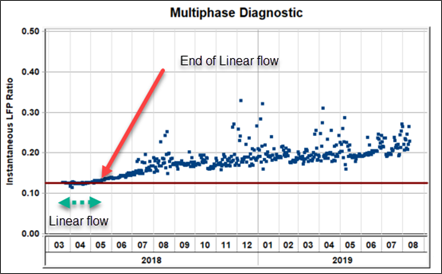
Since all parameters of the BL model are known, (4hxf nf √k)BL is also known, therefore the LFP of the HM model can be calculated using equations 2.
Equation 7: Main outcome of the numerical URM analysis

Additionally, the same plot can be used to estimate the time to the end of linear flow (telf). The BL model stays in a transient linear flow regime throughout the entire production history, while the actual well may transition to boundary-dominated flow at some point.
At this time,  starts to increase. Therefore, the time when points on the Multiphase Diagnostic plot start curving upward from the flat trend indicates the end of the first transient linear flow.
starts to increase. Therefore, the time when points on the Multiphase Diagnostic plot start curving upward from the flat trend indicates the end of the first transient linear flow.
Parameter breakdown
Similar to the traditional URM, the numerical URM analysis does not immediately give values for individual completion parameters. Instead, the combined parameter of Ac √k = 4hxf nf √k is estimated. Individual parameters can be calculated assuming that other parameters are known. LFP can be broken down into completion parameters using one of the following two ways:
- k is calculated by entering nf and xf , using h from the Properties editor, and Ac √k
- xf is calculated by entering nf and k, using h from the Properties editor and Ac √k
Estimating OFIP
While the BL model stays in transient linear flow throughout the entire production history, the actual well may reach boundary-dominated flow. After this happens, points on the top-left plot start curving upwards. The HM model is assumed to match both the transient linear and the boundary-dominated portion of data. To analyze the boundary-dominated portion of data, additional adjusted base model data is built and run in the background. The adjusted base model is the same as the BL model except it uses a smaller Le such that the model reaches boundary-dominated flow during simulation time. The adjusted model is referred to as the base boundary-dominated model (BBD model).

The size of the BBD model should be such that transition from the transient linear flow to the boundary-dominated flow happens at the same time as it happens for the HM model. This is achieved by trial and error on OFIPSRV and ultimately Le of the BBD model.
Equation 8

Note that this relationship is true not just during the transient linear flow, but throughout the entire production history.
Assuming that the HM model describes the production history closely enough, qHM (t) ≈ qhist (t), therefore:
Equation 9

To add results from the HM model on the Multiphase Diagnostic plot, the BBD model is run at pressure control and qBBD (t) is calculated for each timestep; then  is plotted (red curve).
is plotted (red curve).
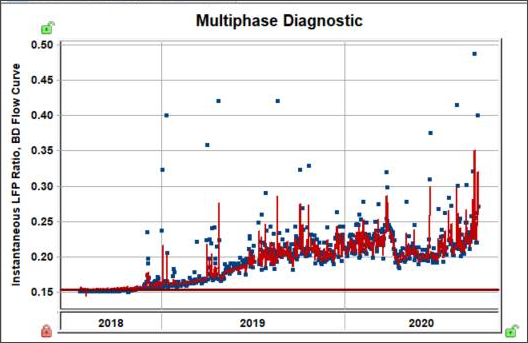
History matching the boundary-dominated portion of the data is done by adjusting the BBD model until:
- Both the BBD model and historical data have the same telf (red line and data points start curving upwards at the same time).
- The HM model matches the boundary-dominated portion of the data (there is a match between the red line and the points on the top-left plot).
After the match is achieved, (OFIP)BBD can be used to calculate (OFIP)HM using this relationship:
Equation 10

Note: History matching the boundary-dominated portion of the data is done by trial and error. For each OFIPSRV, Harmony Enterprise first calculates OFIPBBD using equation 10, and then calculates Le for the BBD model. The qBBD (t) is calculated by synthesizing the BBD model and the HM model results are updated using equation 9.
After the boundary-dominated portion of the data is matched, if the match seems reasonably unique, the OFIPSRV can be used to calculate individual completion parameters (xf and kSRV). Harmony Enterprise calculates xf based on OFIPSRV and Le. Then, permeability is calculated based on this xf and LFP.
History match plot
After both the liner and boundary-dominated portions of data are matched, equation 8 can be rearranged to solve for qHM (t):
Equation 11

qHM (t) and qhist (t) are plotted together against time in the lower-left plot.
Accounting for additional pressure drop (low FCD)
Sometimes wells exhibit additional pressure drop. This additional pressure drop may be due to damage around the fracture, low fracture conductivity (FCD), cleanup, or other reasons. In the Multiphase Diagnostic plot, this pressure drop indicates a decreasing portion of the data at the start of production.
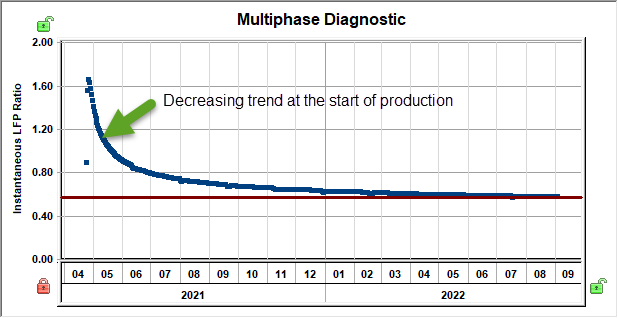
If this additional pressure drop behaves as a pressure drop due to skin (that is, it is proportional to the primary rate), it can be accounted for.
If we define a damage factor for the well as ∆Ps, additional pressure drop due to skin at each time can be expressed as ∆Ps *qhist (t). Therefore, equation 4 can be modified as:
Equation 4a

Combining equations 1 and 4a and using qHM (t ) ≈ qhist (t), the LFP ratio can be expressed as:
Equation 6a

This can be rearranged as:
Equation 12

Equation 12 is used to build the Effect of Skin plot: 
The portion of the data corresponding to early flow follows a straight line with the slope of ∆Ps and the intercept of the LFP ratio.
The Multiphase Diagnostic plot should also be modified following equation 6a by plotting  against time.
against time.
During the first linear flow, these points are supposed to approximately follow a flat line. The position of the line gives the value of the LFP ratio.
Equation 6a can be modified for boundary-dominated flow assuming qHM (t ) ≈ qhist (t):
Equation 13

Equation 13 can be rearranged and solved for qHM (t):
Equation 11a

Equation 11a is used to calculate the rate for the HM model (History plot).
Note that the above derivation is all done under the assumption that the additional pressure drop is proportional to the primary rate. In reality this may not always be the case, so you should use this correction with caution. We recommend using this correction only if you see:
- a decreasing slope at the start of production on the Multiphase Diagnostic plot, and
- a clear increasing linear trend on the Effect of Skin plot, and
- a decreasing slope at the start becomes more flat after the correction is applied
